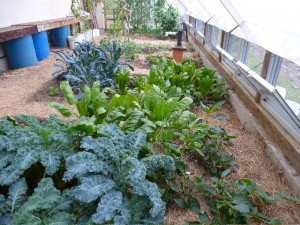
Kale and chard growing in the greenhouse for winter greens
By Sylvia Davatz
“But what will I do for salad in January?” runs the perennial question when one advocates eating locally. This lament has sent me on a mission to explore the growing season’s extension from every angle. In late fall, as I cruise the valley, it saddens me to see so many gardens wiped clear of any signs of growth, when we could still be harvesting such wealth.
Season-extension happens in several ways. The most obvious is keeping our gardens producing as long as possible. Many hardy greens such as kale, Swisschard, arugula, some lettuces, escarole, endive, radicchio, all cabbages, Brussels sprouts, celery, parsley, spinach, cilantro, and corn salad will continue to thrive even through a light frost. Some even improve in flavor from the cold. Other crops, such as beets, carrots, parsnips, leeks can be left in the garden till the ground threatens to freeze, and then moved to the root cellar. A simple hoop house will go a long way toward storing root crops for eating during most of the winter, and protecting hardy greens from snow.

Greenhouse tomatoes for eating into early December.
Paying attention to the choice of specific varieties is another way to stretch fall harvesting. Bionda a cuore pieno, or blond full heart escarole, is one of the hardiest varieties I’ve found. Likewise, a parsley called “Comune.”which I picked up at an Italian street market, will survive the winter outside, while the variety “Gigante di Napoli” will not. Red Russian kale is tender and extremely cold hardy. Corn salad, or mâche, will survive freezing.
If you are lucky enough to have a greenhouse where the ground does not freeze, you might harvest greens almost all winter. Move root crops there instead of into the root cellar.
Fresh fruit is one of the great challenges to local eating. There’s a melon variety called Valencia Winter which remains crisp and juicy up to four months after harvest. Wild berries and pawpaw pulp can be frozen for February breakfasts.
Come early spring, look to the self-sowers. Reserve a patch of garden for the greens that have gone to seed. When the snow melts you’ll have cilantro, corn salad, spinach, some lettuce volunteers, bok choy and perennial arugula—not to mention dandelion greens and other nutritious weeds!
And finally, we need to adjust our expectations for winter eating. A January salad does not need to consist of butterhead lettuce. Instead, grated carrot or shaved cabbage, with a simple lemon juice and olive oil dressing, provide freshness and crunch.
Sylvia Davatz, a 20-year seed saver, helped found the Upper Valley Seed Savers Group and the Grassroots Seed Network for the exchange of open-pollinated seeds. Reach her at sdav@valley.net.








Leave a Reply